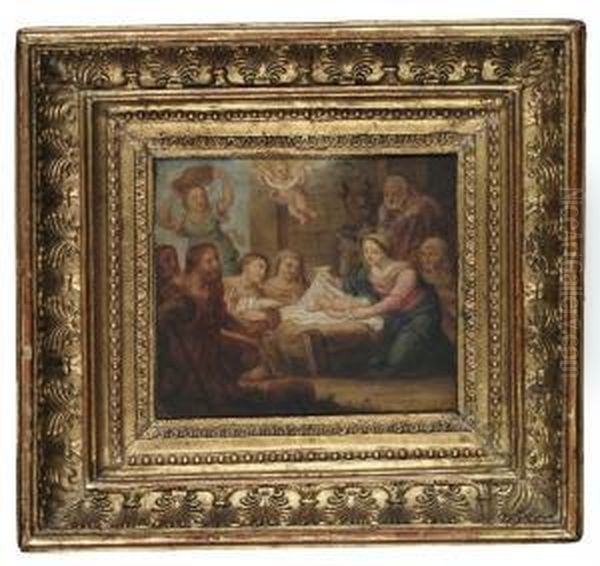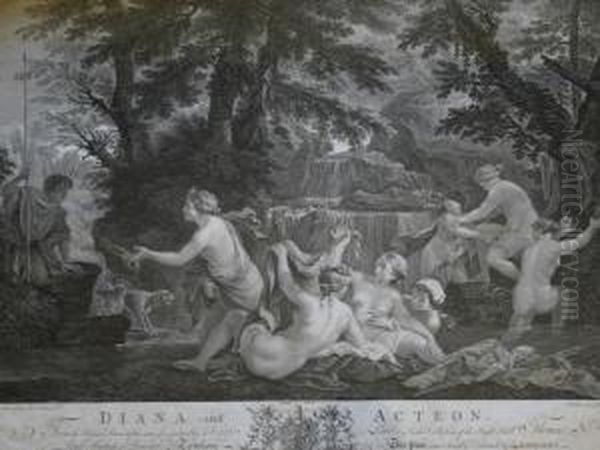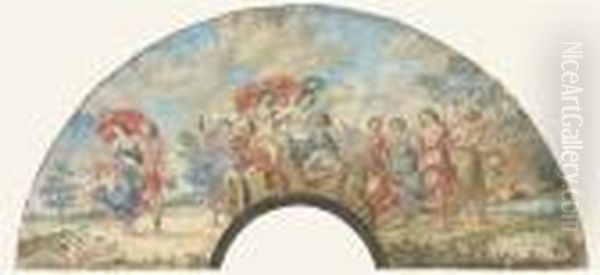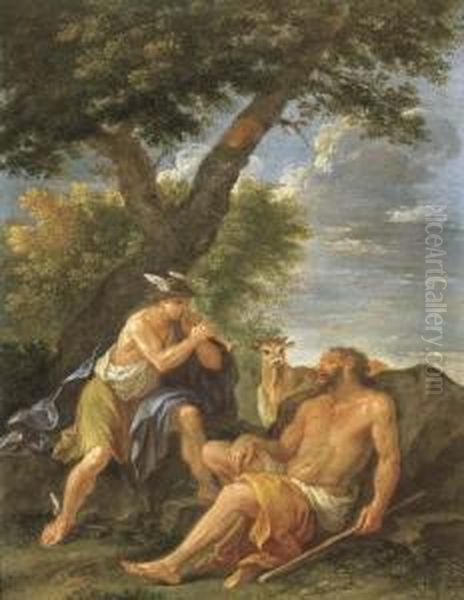Filippo Lauri stands as a significant, if sometimes overlooked, figure in the vibrant tapestry of Roman Baroque art. Active during a period of immense artistic innovation and patronage, Lauri carved a niche for himself with his elegantly composed mythological and religious scenes, often executed on a smaller scale suitable for private collectors. His work, characterized by delicate brushwork, harmonious color palettes, and a profound understanding of classical narratives, offers a fascinating window into the artistic currents of seventeenth-century Rome. He navigated a world populated by artistic giants, collaborating with some and developing a style that, while rooted in established traditions, possessed a unique and enduring charm.
Early Life and Artistic Formation in a Creative Household
Filippo Lauri was born in Rome on August 25, 1623, into a family already steeped in artistic pursuits. His father was Balthasar Lauwers, a Flemish landscape painter who had Italianized his surname to "Lauri" upon settling in Rome. This connection to the Netherlandish tradition, with its emphasis on detailed observation and landscape, likely provided an early, albeit indirect, influence on the young Filippo. His elder brother, Francesco Lauri, also pursued a career as a painter, further immersing Filippo in an environment where art was a daily practice and discussion.
His initial artistic training commenced under his father and then his brother Francesco. This familial tutelage provided a foundational understanding of painting techniques. However, a more formative period in his development came when he began working for Angelo Caroselli, a painter known for his eclectic style, which included genre scenes, portraits, and pastiches of earlier masters. Caroselli was also his future father-in-law, creating a close personal and professional bond. Working in Caroselli's studio would have exposed Lauri to a diverse range of artistic approaches and subject matter, broadening his technical skills and thematic repertoire.

The most significant influence on Lauri’s mature style, however, came from his apprenticeship with Andrea Sacchi. Sacchi was a leading proponent of a more classical, restrained strand of Baroque art in Rome, often seen as an alternative to the High Baroque exuberance of artists like Pietro da Cortona. Sacchi emphasized clarity of composition, idealized figures, and a thoughtful engagement with classical antiquity and the High Renaissance masters, particularly Raphael. Under Sacchi's guidance, Lauri honed his skills in drawing (disegno), figure painting, and the creation of balanced, harmonious compositions, elements that would become hallmarks of his own work.
The Roman Artistic Milieu: A Crucible of Talent
Seventeenth-century Rome was the undisputed center of the European art world. It attracted artists from across Italy and beyond, all eager to study its ancient ruins, its Renaissance masterpieces, and to compete for prestigious commissions from the Papacy, noble families, and religious orders. The artistic scene was incredibly dynamic, characterized by a rich interplay of different styles and philosophies. The powerful, dramatic naturalism of Caravaggio, though from an earlier generation, still cast a long shadow, while the classical idealism of Annibale Carracci and his Bolognese followers provided a strong counterpoint.
Towering figures like Gian Lorenzo Bernini dominated sculpture and architecture, and his influence extended to painting through his dynamic compositions and theatricality. In painting, Pietro da Cortona was a key figure of the High Baroque, known for his vast, illusionistic ceiling frescoes filled with swirling figures and vibrant color. Andrea Sacchi, Lauri's teacher, represented a more measured, classical approach, advocating for compositions with fewer figures to ensure clarity and emotional impact, a debate famously played out in the Accademia di San Luca.
Within this environment, artists like Nicolas Poussin and Claude Lorrain, Frenchmen who spent most of their careers in Rome, also made significant contributions. Poussin became a paragon of classical landscape and history painting, emphasizing order, reason, and moral gravity. Lorrain, on the other hand, perfected the idealized landscape, suffused with poetic light and often populated with small biblical or mythological figures. It was in this rich, competitive, and intellectually stimulating atmosphere that Filippo Lauri developed his career.
Development of a Distinctive Style: Elegance and Intimacy
Filippo Lauri’s art is distinguished by its elegance, refinement, and often, its intimate scale. While he did undertake some larger decorative projects, he became particularly renowned for his cabinet pictures – smaller paintings intended for the private enjoyment of connoisseurs and collectors. These works typically featured mythological, allegorical, or biblical scenes, rendered with a delicate touch and a keen eye for detail.

His style reflects the classical training received under Sacchi, evident in the graceful poses of his figures, the clarity of his narratives, and the balanced nature of his compositions. However, Lauri infused this classicism with a softer, more lyrical quality. His figures, often slender and elegant, are imbued with a gentle charm rather than heroic grandeur. His color palettes are typically harmonious and pleasing, with subtle gradations of tone. He was particularly adept at depicting textures, such as shimmering silks or the soft down of feathers, which added a tactile quality to his work.
Lauri’s approach to landscape, often an integral part of his narrative scenes, shows an appreciation for the idyllic. While not as central as in the works of dedicated landscape painters like Claude Lorrain or Gaspard Dughet (Poussin's brother-in-law and a notable landscape artist), Lauri’s settings are carefully composed to complement the mood and subject of the painting. These landscapes often feature feathery trees, distant hazy mountains, and a soft, diffused light, creating an atmosphere of pastoral serenity or mythological enchantment. Influences from the Bolognese school, particularly artists like Francesco Albani and Domenichino, known for their idyllic mythological landscapes and graceful figures, can also be discerned in Lauri's approach.
Major Themes and Representative Works
Mythology was a recurrent and favored theme in Filippo Lauri's oeuvre. He drew extensively from Ovid's Metamorphoses and other classical sources, depicting well-known tales of gods, goddesses, nymphs, and satyrs. These subjects allowed him to explore themes of love, beauty, transience, and divine power, while also providing ample opportunity to showcase his skill in rendering the human form and creating engaging narrative compositions.
One of his celebrated works is Venus and Adonis. This subject, a poignant tale of love and loss, was popular during the Baroque period. Lauri’s interpretations typically emphasize the tenderness and beauty of the scene, often set within a lush, idyllic landscape. His figures of Venus and Adonis are characterized by their graceful forms and expressive gestures, conveying the emotional intensity of the narrative with a refined sensibility. The compositions are carefully balanced, drawing the viewer's eye to the central figures while integrating them harmoniously with their surroundings.
Another significant mythological painting is The Punishment of Marsyas. This dramatic story, where the satyr Marsyas is flayed alive for daring to challenge Apollo in a musical contest, allowed Lauri to explore more intense emotions and a greater sense of pathos. While the subject is inherently gruesome, Lauri often tempered the brutality with his characteristic elegance, focusing on the tragic dignity of Marsyas and the stern justice of Apollo.

Religious subjects also formed an important part of Lauri's output. He painted scenes from the Old and New Testaments, often imbuing them with the same grace and sensitivity found in his mythological works. Paintings such as The Adoration of the Shepherds or The Rest on the Flight into Egypt showcase his ability to convey piety and tenderness through delicate figures and serene settings. His religious works were sought after for private devotion as well as for smaller chapels.
Lauri also excelled in allegorical subjects. A notable example is his Allegory of Spring with Bacchic Dance. Such works demonstrate his ability to translate abstract concepts into visually engaging narratives, often populated by lively figures and symbolic elements. The Allegory of Spring would typically feature Flora, nymphs, and putti in a joyous celebration of nature's renewal, rendered with a light, airy touch and vibrant colors. His skill in depicting lively, dancing figures is particularly evident in such compositions.
His works often feature a recurring cast of figure types – slender, graceful nymphs, athletic young gods, and charming putti – which, while contributing to his recognizable style, sometimes led to accusations of a limited repertoire by later critics. However, within these conventions, Lauri consistently demonstrated a high level of technical skill and a refined aesthetic sensibility.
Collaborations and Professional Relationships: The "Circle of Filippo Lauri"
Collaboration was a common practice in the bustling art world of seventeenth-century Rome, allowing artists to combine their specialized skills to produce complex works efficiently. Filippo Lauri was a sought-after collaborator, particularly for his skill in painting small, elegant figures.
One of his most frequent and notable collaborators was Claude Lorrain. Lorrain was a master of the idealized landscape, creating poetic visions of the Roman Campagna and imaginary classical settings. However, he was reportedly less confident in his figure painting. Lauri often provided the small mythological or biblical figures (staffage) that populated Lorrain's luminous landscapes. These collaborations resulted in some of the most admired paintings of the period, where Lauri's graceful figures perfectly complemented Lorrain's atmospheric settings. This partnership highlights Lauri's reputation for figural excellence, even on a diminutive scale.

Lauri also collaborated with Filippo Gagliardi, a painter specializing in architectural perspectives (quadratura). Together, they worked on significant projects, including depictions of contemporary events. A prime example is the series of paintings or designs celebrating the arrival of Queen Christina of Sweden in Rome in 1655, a major event for the city. For instance, they collaborated on a large painting depicting the Carousel or Joust in Palazzo Barberini in honour of Queen Christina of Sweden, where Gagliardi would have handled the complex architectural setting of the palace courtyard, and Lauri the numerous figures participating in the festivities.
He is also known to have worked with other landscape painters, such as Gaspard Dughet, adding figures to their compositions. His family connections remained important, and the term "Circle of Filippo Lauri" can be understood to encompass not only his direct collaborators but also his family members (his father Balthasar and brother Francesco), his teacher Andrea Sacchi, and other artists whose style or thematic concerns intersected with his own. This circle would also include artists like Luigi Garzi, with whom he reportedly worked on decorative schemes, such as for the Palazzo Borghese. The artistic environment was one of mutual influence and, at times, shared projects.
These collaborations underscore Lauri's versatility and his esteemed position among his peers. His ability to seamlessly integrate his figures into the diverse styles of other painters speaks to his adaptability and technical proficiency.
The Accademia di San Luca and Esteem in Rome
Filippo Lauri's talent and professionalism earned him significant recognition within the Roman artistic community. A key indicator of his standing was his involvement with the Accademia di San Luca, the prestigious artists' academy in Rome. He became a member of the Accademia in 1654, an important step for any artist seeking to establish their reputation and influence in the city.
The Accademia was not merely an honorary society; it played a crucial role in art education, theoretical debates, and the regulation of artistic practice in Rome. Membership conferred status and provided opportunities for networking and patronage. Lauri's involvement deepened over time, and he eventually rose to the esteemed position of Principe (President or Director) of the Accademia di San Luca in 1684-85. This was a significant honor, reflecting the high regard in which he was held by his fellow artists. As Principe, he would have been responsible for overseeing the Academy's activities, guiding its artistic direction, and representing its interests.
His tenure as Principe places him in the company of other distinguished artists who held the post, such as his teacher Andrea Sacchi, and later, Carlo Maratta, who became a dominant figure in Roman classicism towards the end of the century. Lauri's leadership role signifies his acceptance into the highest echelons of the Roman art establishment.
Patronage, Collection, and Lasting Legacy
Filippo Lauri enjoyed considerable success throughout his career, attracting a distinguished clientele. His elegant and refined paintings, particularly his cabinet-sized mythological and religious scenes, were highly sought after by Roman noble families and discerning collectors. Prominent families such as the Chigi, Colonna, and Pallavicini were among his patrons, acquiring his works to adorn their lavish palaces. The intimate scale and polished finish of his paintings made them ideal for private galleries and studioli, where they could be appreciated up close.
His reputation extended beyond Rome. Lauri's works were exported to other parts of Italy and internationally, finding their way into collections in England, France, and Spain. This international demand attests to the broad appeal of his graceful style and charming subject matter. The presence of his works in such diverse collections helped to disseminate his artistic influence.
While Lauri may not have achieved the monumental fame of contemporaries like Bernini or Pietro da Cortona, his contribution to Baroque art is significant. He excelled in a particular niche, creating works of enduring beauty and refinement. He is often described as a "master of the small format," demonstrating that artistic impact is not solely dependent on scale. His ability to convey complex narratives and subtle emotions within relatively small compositions is a testament to his skill.
Filippo Lauri passed away in Rome on December 12, 1694, leaving behind a substantial body of work that continued to be appreciated by collectors and connoisseurs. His paintings are now found in major museums and private collections around the world, including the Uffizi Gallery in Florence, the Louvre in Paris, the Hermitage Museum in St. Petersburg, and the National Gallery in London.
His legacy lies in his distinctive fusion of classical principles with a gentle, lyrical sensibility. He provided a more intimate and accessible counterpoint to the grand theatricality of High Baroque art, catering to a taste for refined elegance and mythological charm. Artists like Carlo Maratta, who became the leading painter in Rome in the later 17th and early 18th centuries, continued the classical tradition, though with a grander and more formal style than Lauri's. However, Lauri's dedication to graceful figuration and harmonious composition ensured his place within this enduring artistic current.
Conclusion: An Enduring Appeal
Filippo Lauri was an artist who skillfully navigated the complex and competitive art world of seventeenth-century Rome. Born into an artistic family and trained by one of the leading classicists of the day, Andrea Sacchi, he developed a distinctive style characterized by elegance, delicate execution, and a preference for mythological and religious themes rendered on an intimate scale. His collaborations with renowned artists like Claude Lorrain and Filippo Gagliardi, and his leadership of the Accademia di San Luca, attest to his respected position among his peers.
While the grand pronouncements of artists like Salvator Rosa with his wild landscapes, or the dramatic intensity of the Caravaggisti, represented other facets of the Baroque, Lauri's art offered a vision of refined beauty and classical harmony. His paintings, with their graceful figures, idyllic landscapes, and charming narratives, continue to delight viewers and provide valuable insight into the tastes and artistic currents of his time. Filippo Lauri remains a testament to the enduring appeal of elegance and masterful storytelling in art, a painter whose delicate touch and refined vision secured him a lasting place in the history of Italian Baroque painting.